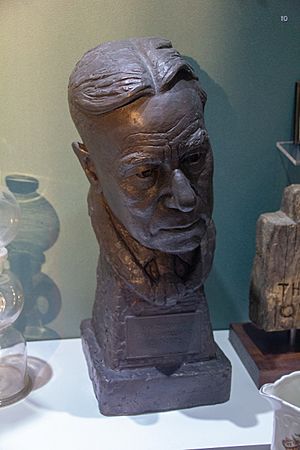T. H. Parry-Williams facts for kids
Quick facts for kids
Y Prifardd
Sir T. H. Parry-Williams
|
|
|---|---|

Portrait bust (1966) by Robert Lambert Gapper
|
|
| Born | 21 September 1887 Tŷ'r Ysgol, Rhyd Ddu, Caernarfonshire, Wales
|
| Died | 3 March 1975 (aged 87) Wern, North Road, Aberystwyth, Dyfed, Wales
|
| Resting place | Beddgelert Cemetery, Beddgelert, Gwynedd, Wales |
| Nationality | Welsh |
| Education | Ysgol Eifionydd, Porthmadog |
| Alma mater |
|
| Occupation | Academic, author and poet |
|
Notable work
|
"Hon" |
| Title | Emeritus Professor of Welsh Language and Literature |
| Spouse(s) | Emiah Jane Thomas (1910–1988) |
| Parent(s) | Henry Parry-Williams (1858–1925) and Ann Morris (b. 1859) |
| Relatives | Robert Williams Parry (1884–1956) and Sir Thomas Parry (1904–1985) (1st cousins) |
| Awards | National Eisteddfod Chair (1912 and 1915); National Eisteddfod Crown (1912 and 1915); D.Litt. (Wales) (1934); D.Litt. (Oxon.) (1937); Kt (1958) |
Sir Thomas Herbert Parry-Williams (born September 21, 1887 – died March 3, 1975) was a very important Welsh poet, writer, and university professor. He is famous for his beautiful poems and essays, and for teaching Welsh language and literature.
Contents
Early Life and Education
Thomas Herbert Parry-Williams was born in a place called Tŷ'r Ysgol, which means 'the Schoolhouse'. This was in Rhyd Ddu, a village in Caernarfonshire, Wales.
He went to several universities to study. These included the University College of Wales in Aberystwyth, Jesus College, Oxford in England, and universities in Freiburg, Germany, and Paris, France. He studied many different subjects and became a very knowledgeable person.
During the First World War, he was a conscientious objector. This means he believed that war was wrong and chose not to fight.
A Champion Poet
Sir T. H. Parry-Williams was an amazing poet. He made history at the National Eisteddfod of Wales, which is a big festival of Welsh culture.
He was the first person ever to win both the 'Chair' and the 'Crown' awards at the same Eisteddfod. The 'Chair' is for a long poem written in a very strict traditional Welsh style. The 'Crown' is for a poem written in a more modern, free style.
He first won both awards in Wrexham in 1912. He then achieved this incredible feat again in Bangor in 1915. This showed how talented he was in different kinds of poetry.
University Professor and Scholar
From 1920 to 1952, Sir T. H. Parry-Williams was a professor at the University of Wales, Aberystwyth. He taught Welsh language and literature to students.
He also helped start the university's Centre for Advanced Welsh and Celtic studies. This center helps people learn more about the Welsh language and other Celtic languages and cultures.
In 1931, he worked on a special project. He published a collection of poems by an old Welsh poet named St. Richard Gwyn. He also included old writings about Richard Gwyn's life.
Awards and Recognition
Sir T. H. Parry-Williams received many important awards for his work. He was given special degrees called D.Litt. from the Universities of Wales in 1934 and Oxford in 1937.
In 1958, he was made a Knight by the Queen. This meant he could use "Sir" before his name. He also received an honorary doctorate from the University of Wales in 1960. Later, in 1968, he became an Honorary Fellow of Jesus College, Oxford.
Published Works
Sir T. H. Parry-Williams wrote many books during his life. These included collections of his poems and essays. His writings are still studied and enjoyed by people who love Welsh literature.

